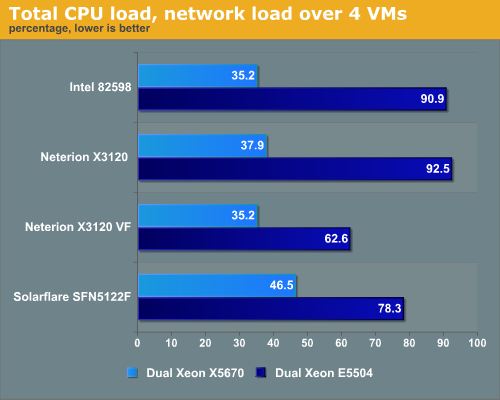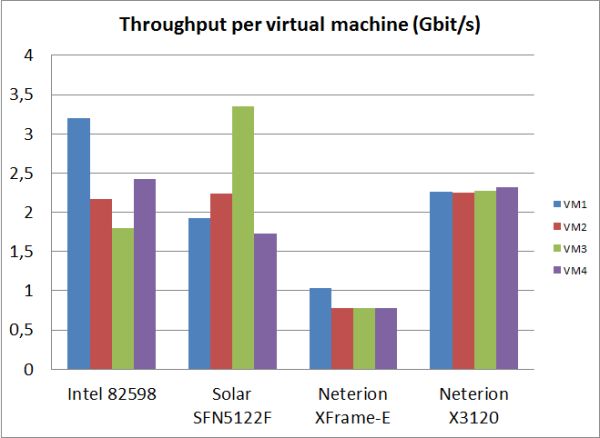10G Ethernet: More Than a Big Pipe
by Johan De Gelas on November 24, 2010 2:34 PM EST- Posted in
- IT Computing
- Networking
- 10G Ethernet
ESX 4.0 Performance
Let us see what these NICs can do in a virtualized environment. After some testing in ESX 4.1 we had to go back to ESX 4.0 u2 as there were lots of driver issues, and this surely was not the NIC vendors fault solely. Apparantly, VMDirectPath is broken in ESX 4.1, and a bug report has been filed: update 1 should take care of this.
We started NTttcp from the Windows 2008 node:
NTttcp –m 4,0, [ip number] -a 4 –t 120
On the “virtualized node”, we created four virtual machines with Windows 2008. Each VM gets four network load threads. In other words, there are 16 threads active, all sending network traffic through one NIC port.
The Intel chip delivered the highest throughput with 9.6 Gb/s, followed closely by the Solarflare (9.2 Gbit/s) and the Neterion X3100 (9.1 Gbit/s). The old Xframe-E was not capable of delivering more than 3.4 Gbit/s. The difference between the top three is hardly worth discussing: few people are going to notice a bandwidth increase of 5%. However, notice that the Neterion NIC is the one that load balances the traffic the fairest over the four VMs. All Virtual machines get the same bandwidth: about 2.2 to 2.3 Gbit/s. The Solarflare SF5122F and Intel 82598 are not that bad either: the lowest bandwidth was 1.8 Gbit/s. Bandwidth tests with the Ixia Chariot 5.4 test suite gave the same numbers. We also measured response times.

Again, the Neterion X3100 chip stands out with a low response time in all virtual machines. The Solarflare SF5122 drops a stitch here as one VM gets twice the amount of latency. Let us see how much CPU power these NICs needed while they round-robin the network traffic over to the virtual machines. This test was done on the Xeon E5504 (2GHz) and the Xeon X5670 (2.93GHz); Hyper-Threading was disabled on all CPUs.

Nine gigabits of paravirtualized network traffic is enough to swamp the dual quad-core 2GHz Xeon CPU in most cases. Although it is one of slowest Xeons now available, it is still impressive that nothing less than eight of these cores are necessary just to run the benchmark and manage the network traffic. So be warned that these 10GbE NICs require some heavy CPU power. The Solarflare chip offers the low-end Xeon some breathing space, the Neterion chip needs the most for it’s almost perfect load balancing services.
But the Neterion chip has a secret weapon: it is the only NIC that can make virtual functions available in VMware ESX. Once you do this, the CPU load is a lot lower: we measured only 63%. This lower CPU load is accompagnied with a small dip in the network bandwidth: we achieved 8.1 Gbit/s instead of 9.1 Gbit/s.
Once we use one of the fastest Xeons available, the picture changes. The Intel and Neterion make better use of the extra cores and higher frequency.











38 Comments
View All Comments
Kahlow - Friday, November 26, 2010 - link
Great article! The argument between fiber and 10gig E is interesting but from what I have seen it is extremely application and workload dependant that you would have to have a 100 page review to be able to figure out what media is better for what workload.Also, in most cases your disk arrays are the real bottleneck and max’ing your 10gig E or your FC isn’t the issue.
It is good to have a reference point though and to see what 10gig translates to under testing.
Thanks for the review,
JohanAnandtech - Friday, November 26, 2010 - link
Thanks.I agree that it highly depends on the workload. However, there are lots and lots of smaller setups out there that are now using unnecessarily complicated and expensive setups (several physical separated GbE and FC). One of objective was to show that there is an alternative. As many readers have confirmed, a dual 10GbE can be a great solution if your not running some massive databases.
pablo906 - Friday, November 26, 2010 - link
It's free and you can get it up and running in no time. It's gaining a tremendous amount of users because of the recent Virtual Desktop licensing program Citrix pushed. You could double your XenApp (MetaFrame Presentation Server) license count and upgrade them to XenDesktop for a very low price, cheaper than buying additonal XenApp licenses. I know of at least 10 very large organizations that are testing XenDesktop and preparing rollouts right now.What gives. VMWare is not the only Hypervisor out there.
wilber67 - Sunday, November 28, 2010 - link
Am I missing something in some of the comments?Many are discussing FCoE and I do not believe any of the NICs tested were CNAs, just 10GE NICs.
FCoE requires a CNA (Converged Network Adapter). Also, you cannot connect them to a garden variety 10GE switch and use FCoE. . And, don't forget that you cannot route FCoE.
gdahlm - Sunday, November 28, 2010 - link
You can use software initiators on switches which support 802.3X flow control. Many web managed switches do support 802.3X as do most 10GE adapters.I am unsure how that would effect performance at in a virtualized shared environment as I believe it pauses on the port level.
If you workload is not storage or network bound it would work but I am betting that when you hit that hard knee in your performance curve that things get ugly pretty quick.
DyCeLL - Sunday, December 5, 2010 - link
To bad HP virtual connect couldn't be tested (a blade option).It splits the 10GB nics in a max of 8 Nics for the blades. It can do it for fiber and ethernet.
Check: http://h18004.www1.hp.com/products/blades/virtualc...
James5mith - Friday, February 18, 2011 - link
I still think that 40Gbps Infiniband is the best solution. By far it seems to be the best $/Gbps ratio of any of the platforms. Not to mention it can pass pretty much any traffic type you want.saah - Thursday, March 24, 2011 - link
I loved the article.I just reminded myself that VMware published official drivers for the ESX4 recently: http://downloads.vmware.com/d/details/esx4x_intel_...
The ixgbe version is 3.1.17.1.
Since the post says that "enables support for products based on the Intel 82598 and 82599 10 Gigabit Ethernet Controllers." I would like to see the test redone with an 82599-based card and recent drivers.
Would it be feasible?